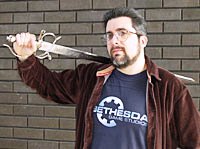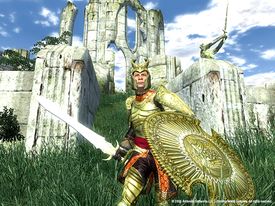General:Steve Meister: To the Death, or to the Pain
This is a developer diary for The Elder Scrolls IV: Oblivion. The original diary can be found here.
Steve Meister- Programmer
"He will win who knows when to fight and when not to fight. He will win who knows how to handle both superior and inferior forces. He will win who, prepared himself, waits to take the enemy unprepared.
-Sun Tzu, the Art of War
You're walking through a seedy part of a town in Western Cyrodiil. People mill about, some engaged in conversation, others minding their own business out on their own errands. Suddenly, an ugly man decides he doesn't like you. Maybe he's drunk, maybe he's just a bully, maybe he's just showing off in front of his friends -- but for whatever reason, he has taken your measure and decided he can best you.
He comes charging at you, with a nasty looking mace in his hand and a look of hatred on his face. Onlookers move back to make room for what should be an entertaining fight.
Quickly drawing your sword and shield, you wheel around to face him. He's upon you pretty quickly though, and you barely have time to raise your shield (hold right mouse button) before his first blow thunders down upon you.
But you block well, and as he recoils from the collision, you quickly perform left & right slashes with your sword (two clicks of the left mouse button, about a second apart). The bully realizes this isn't going to be easy.
He backs off a bit, and starts dodging around you. First to the left, then to the right. You maneuver to keep him in view, looking for an opening. Suddenly he steps back, raises his mace in both hands, and steps forward, bringing the mace towards your head in a crushing blow!
But you're quick -- you step to the side as he attacks. As he passes by, you execute a spinning maneuver and slash him in the side (hold left mouse button and left maneuver key). The hit is solid, and your foe staggers from the blow.
But it's not over yet. The bully swings his mace wildly -- his first swing misses, but the next one connects for a blow that sends you staggering. Pressing his advantage, the bully bears down on you with a power attack of his own. OUCH. This isn't going well. You take a glance at your health meter; it's getting a bit low. You quickly back up out of the bully's reach and raise your shield (hold right mouse button).
He's hurting, too. You circle each other for a time, looking for an opening, trying to recover some fatigue. Finally the bully charges forward with a devastating overhead blow, perhaps hoping to break your shield. But the shield holds and the recoil send him staggering back. This is your chance! You perform a mighty forward power attack (hold the left mouse button, press forward) and connect solidly. The blow staggers your foe once again, and you perform 3 slashing attacks in rapid succession (three taps on the left mouse button, about a second apart), and finally the bully collapses to the ground, defeated.
The crowd disperses, going back to their own business.
Hello folks, it's MrSmileyFaceDude again, and this time 'round I'm going to talk about combat in Oblivion. Since Morrowind, we've made a lot of changes, both in how you, the player, control combat and in how NPCs and creatures handle things. Gone are the days of "Always Use Best Attack." Button mashing will NOT result in successful combat. Skills and stats are still as crucial as ever. The goal is to make combat exciting, violent and fun, while still maintaining the balance between character skills and player skills.
So what's new? First of all, weapons only have one damage rating. Gone are the three attack types from Morrowind - Chop, Slash, and Thrust. Instead, the damage rating simply indicates the base damage the weapon can do. That damage value will be modified based on the attacker's skill, luck, fatigue, type of attack selected (more on that in a second), and on the target's defensive stats, armor, fatigue, and whether or not they're blocking...and even the weapon's condition comes into play.
In Morrowind, you selected the type of attack you wanted to do (Thrust, Chop, Slash) by pressing the attack button in conjunction with a movement key. Or you just turned on the "Always Use Best Attack" option, since for some weapons there wasn't much point in choosing anything BUT the best attack. For Oblivion, selecting attacks is different.
To perform "normal" attacks, you just click the attack button to swing your melee weapon. If you click again at a certain point in the swing, you can perform another attack on the back swing - so you can do multiple slashes with your weapon by properly timed clicks of the attack button. Each time you attack, some fatigue is burned.
We've also added a new kind of attack called a "Power Attack". Power attacks do significantly more damage than normal attacks, but they take longer to perform (leaving you vulnerable) and burn more fatigue. You perform a power attack by holding the attack button down briefly while either standing still or selecting a direction. For example, if you hold down the left movement key and press and hold the attack button with a sword equipped your character will do a cool spinning attack while moving to the left. (No, the camera doesn't spin in first person - trust me, you'd need a bucket next to your gaming setup if we put THAT in!) And as your skills progress, you earn new power attacks.
All of the attacks - "normal" and power attacks - are appropriate for the weapon type. No more thrusting hammers or axes.
In Morrowind, blocking was done automatically, based on your blocking skill. For Oblivion, blocking is now performed manually using a block button. Just hold the button, and you can block - either with your shield OR with a weapon. If you're facing an opponent and you block, some of the damage from your opponent's attack will be absorbed by the shield or weapon you're blocking with. But be sure to watch that weapon condition -- broken swords are useless until they're repaired! You can even block with your hands if you're in hand-to-hand combat. But wait, you say, why would you do that, since there's no shield or weapon to absorb the damage?
The answer is another new feature: recoil. If an attacker's blow is blocked, the attacker will recoil. Think of a sword bouncing off a shield. Recoils send the opponent back a little bit, and it takes a second or two for them to recover - an excellent opportunity to press your advantage. Now there are two reasons to block - to protect yourself from maximum damage, and to try to force your opponent to recoil so you can perform a counter attack. Of course, you'll recoil too if your own attack is blocked - and you can be sure your opponent will be taking advantage of your temporary vulnerability!
Combatants hit hard enough will stagger from the blow. Like recoil, a staggered opponent is briefly vulnerable to attacks.
Hand-to-hand combat is improved as well. As with melee combat, there are "normal" attacks - left & right punches - as well as power attacks. One big difference is that hand-to-hand hits will damage health as well as fatigue. In Morrowind, only the opponent's fatigue was damaged until the opponent was unconscious, after which the opponent's health was damaged by further hand-to-hand hits. The base amount of health and fatigue damage done is based on the attacker's hand-to-hand skill and luck, and as with weapon attacks, that amount is further adjusted based on the defender's stats.
While I'm not going to get too much into magic, I will mention this: you can cast spells at any time. You no longer need to "switch" to magic. If you only have one free hand, you'll cast with the empty one. If both hands are holding something, you'll cast with your weapon hand. There's no more "ready magic" button, just a "cast" button. This makes for some very exciting combat, since you can alternate weapon attacks and spell casting on the fly.
OK, so the player character has a lot of meaningful combat options available, accessed with a simple control scheme that's very similar to Morrowind's. Stats are every bit as crucial as in previous Elder Scrolls games. But what about NPC's? How has their combat behavior been enhanced?
First of all, NPC's can do everything the player can do. They can move around, block, use normal and power attacks, mix things up with weapon or hand-to-hand combat, or magic, etc. So can creatures. And it's all customizable using a new feature called a Combat Style.
Combat Styles are collections of settings related to combat behavior. They dictate things like how often a combatant will move around, how often and under what circumstances they'll attack or block, how often they'll use power attacks and how they choose which ones to use, and even things like how likely a combatant is to attack when their opponent is recoiling, staggering, or knocked unconscious. Combat Styles are created in the TES CS and can be assigned to creatures or NPCs either in the editor or via a script function. So, you can swap combat behavior in and out on the fly. It's a very powerful, very flexible system. The Combat AI system makes use of these Combat Styles, along with AI traits set for each NPC or creature such as aggression, confidence, to make most of the decisions during combat.
Other behaviors implemented include intelligent use of buffs (such as fortification potions or spells, summoned creatures, or bound weapons,) restoration, and even counter effect magic. Archers can be set up to maneuver from gap to gap along the top of a castle wall, in order to maintain a visual on their target. And a lot of time has been spent working on path finding and object avoidance. The Combat AI uses our own Radiant AI technology to handle pursuit and fleeing, and even the acquisition of nearby weapons if a combatant is unarmed, among other things. Spectators will clear space for combat they're uninvolved with. NPCs will leave interiors in order to summon guards if a crime is committed, and can flee or pursue through load doors, as well. No more running into a tavern to escape the guards - they'll follow you right in.
And finally, combat need not be lethal. Any combatant - including the player -- can yield to their opponent. It's up to the opponent to accept the yield or not, but if they do accept, combat ends. It's a way to get out of those sticky situations where you find yourself in over your head. Just don't try it with a creature or with anyone who really, really hates you! And if an NPC yields to you, you make the call - walk away, or keep fighting.
So that's my "summary" of combat in Oblivion. There's a lot more, but I hope this gives you an idea of what's in store. We're having a lot of fun with it, and I hope you do too. See you on the forums!

